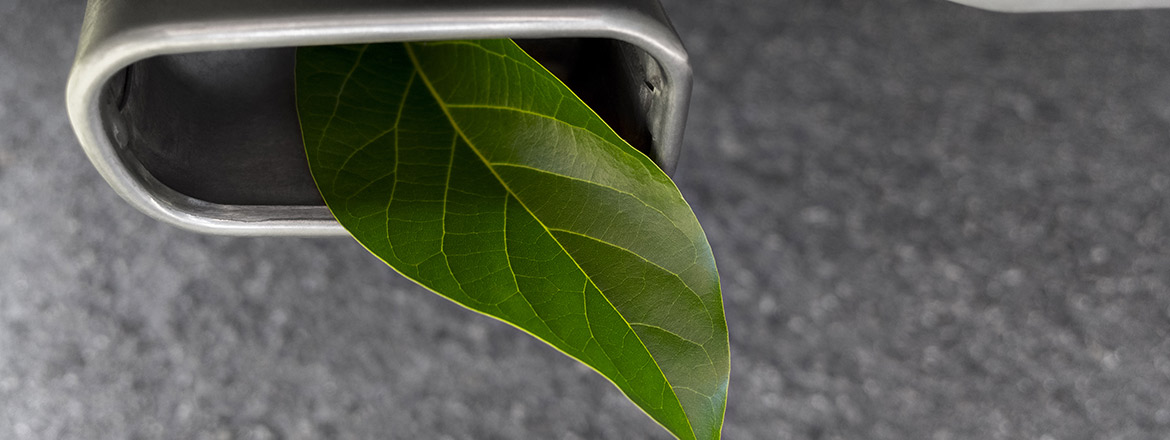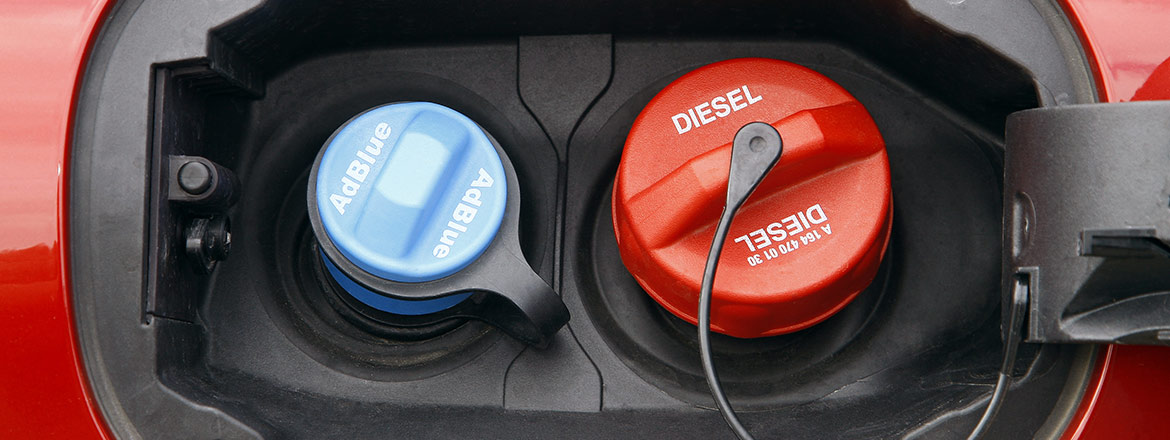Facts and myths about AdBLUE® fluid
Diesel vehicles emit large amounts of nitrogen oxides (NOx) which cause the formation of acid rains and smog. So, when Euro 4 standard was introduced in the EU in 2005/2006, they prescribed a maximum of 0.25 grams of nitrogen oxides per kilometer traveled. For Euro 5 it is 0.18 g/km, and 0.08 g/km for Euro 6.
In response to that, in September 2014, the automotive industry developed Selective Catalytic Reduction (SCR) as one of the best technologies to reduce NOx emissions. According to that, the ISO 22241 standard defined Diesel exhaust fluid (DEF), a solution based on urea and water for the treatment of diesel engine exhaust gases.

AdBlue® affects the reduction of harmful gas emissions.
The best known DEF is AdBlue® fluid, which has been the subject of controversy since it appeared on the market, so now we are going to deal with it in the next following lines.
So, what exactly is AdBlue® fluid?
The most common misconception is that AdBlue® is a diesel fuel additive. This can be dangerous because AdBlue® is NOT a diesel fuel additive and if you accidentally add it to the tank, you can cause a very serious damage - the filter may get blocked and the system will stop receiving fuel.
AdBlue® fluid is one of the Diesel exhaust fluids registered as a trademark of the German Association of the Automotive Industry (Verband der Automobilindustrie, VDA). So, AdBlue® is just a brand of this type of fluid, together with some others such as BlueHDI by the French PSA group. Under the name of AdBlue®, this product can be placed only by the licensed manufacturers, one of which is TotalEnergies, as well as by the authorized distributors.
It’s just urea and water, you can mix it yourself
Urea, or carbamide, is a completely organic compound, a final product of metabolism of proteins and amino acids in mammals. However, AdBlue® consists of high purity urea dissolved and suspended in deionized water. According to the ISO 22241 standard, the ratio of mixtures is made by approximately 32.5% of urea and 67.5% of deionized water. This concentration was carefully chosen because only in this ratio the lowest temperature at which urea crystallizes (freezes) is −11 °C.
Given that AdBlue® solution contains high purity urea, do not try to improvise by dissolving over-the-counter urea in demineralized water as it is not of the same quality and can cause damage to your car.
Note: Even though this is another fluid that doesn’t go well with low temperatures, do not worry - since it consists mainly of water, even if it freezes at very low temperatures, the car heaters will heat it up very quickly and return to its proper condition. The only thing to keep in mind here is that, in order to avoid damages, the tank should not be overfilled because AdBlue® has about 7% more volume after defrosting.

How to warm up your car properly?
How does AdBlue® work?
In vehicles with integrated SCR system, exhaust gas treatment takes place at three levels:
- Firstly, inside Diesel engines, NOx (nitrogen oxides) are produced by the reaction of oxygen and nitrogen at the high temperatures caused by combustion,
- Then, when AdBlue® fluid is injected into the exhaust (more precisely, in the part in front of the SCR catalyst and behind the engine) and begins to heat up, at temperatures above 30 °C it begins to decompose to ammonia (NH3) and carbon-dioxide (CO2),
- Finally, a reaction with ammonia occurs inside the catalyst, so harmful NOx molecules are converted into harmless nitrogen (N3) and water vapor (H2O).
AdBlue® is harmful?
While its name says different, AdBlue® is a colorless, transparent liquid with a mild ammonia odor. Though it is safe, in some people it can cause mild irritation if it comes in contact with the skin, so it is necessary to rinse well with plenty of water. The same goes for the clothes.
AdBlue® is not flammable, but it should be stored in a cool, well-ventilated place and away from sunlight. This will prevent water evaporation and urea crystallization and preserve the quality and lifespan of the product. It will also prevent pressure cracking which happens when the packaging is exposed to high temperatures.
Furthermore, because of its high purity, AdBlue® is easy to contaminate, so it is necessary to store it in its original packaging, taking care that it doesn’t come into contact with dirt, oil, water, dust, anything that can contaminate it and change its composition. You should bear in mind that its maximum shelf life is 12 months and that its quality largely depends on the place and method of storage, so take this into account when buying/storing it.
The water and urea solution is incompatible with many materials, so it can cause corrosion of pipes and components in the fuel system, which repair/replacement can be very expensive. It can also corrode paint on the car bodywork, which is one more reason to refill it carefully.
Given that it is a chemical process, the exhaust gases may have a different smell compared to the one you are used to experience with diesel. Additionally, a "whitish smoke" can come out of the exhaust, but be carefree, it's just a water vapor. However, be careful it doesn’t come in contact with your skin as it may be slightly acidic. If this happens, rinse with plenty of water.

What do unpleasant car smells tell you?
But it does pollute… right?
Numerous scientific studies have proven that SCR technology reduces fuel consumption by about 5%, which directly means lower CO2 emissions. In combination with AdBlue®, the result is minimized emissions of harmful gases (NOx, PM, CO and CH), which is in line with the strict requirements of Euro 4, 5 and Euro 6 standards.
Besides, SCR technology is suitable for all engine types and it is compatible with diesel fuel of all qualities. It does not require any special maintenance and is designed to last as long as the vehicle itself. Also, it has no effect on car service or oil change interval.
When diluted, AdBlue® fluid can even be used as a fertilizer, and given that in the final stage, as we have seen, it turns into water vapor and nitrogen, which are already there in the air, it is completely safe for the environment.
Can I add AdBlue fluid myself?
If your car uses AdBlue®, which you can check in the car manual or conclude based on the engine label (for example, Renault uses the “Blue dCi” label and Peugeot uses the “BlueHDi” label), based on average consumption, the system itself estimates how far you can go with the remaining liquid in the tank and will let you know when it's time to refill it. As the amount of liquid decreases, a warning, increasingly intense message will appear on the instrument panel to alert you to refill AdBlue®.
Depending on the model (see the manual), the AdBlue® tank filler neck can be found in one of these three places:
- Next to the Diesel filler neck,
- Somewhere under the bonnet in the engine compartment,
- Somewhere in the boot.

You can recognize the AdBlue tank opening by the blue refill cap.
To avoid any confusion, the manufacturers have designed an opening with a blue refill cap that leads to a tank designed exclusively for AdBlue® fluid. The tank volume also varies, but on average it can contain between 8 and 25 liters. Its consumption also depends on the model, driving conditions and style, but 1 to 3 liters per 1,000 kilometers traveled is considered normal.
Depending on the manufacturer, model, year of manufacture, engine and other parameters, the car computer might either limit, for example, the maximum revolution, maximum speed, or power, or prevent the engine from starting in case you run out of AdBlue®.
Basically, when the warning light appears, it is usually enough to add about 4 liters to the tank to turn it off and to be able to safely continue driving, though there are also models where the tank must be filled up to the maximum.
Therefore, you can refill AdBlue® fluid yourself, you just have to make sure that the container is in a preserved condition and be careful not to add it to the fuel tank. Of course, you can also do it at an authorized car service center, just don’t do it at pumps that have AdBlue® for trucks and buses — even though it is the same liquid, the tapping pressure is too high and can damage the tank.
Like everything else related to cars, this system is not immune to failures. For example, if the car isn’t driven enough and AdBlue® stays in the tank for a long time, urea may crystallize, which is not good. Additionally, there are various sensors, heaters, nozzles, electronics, each with its own lifespan. Like the DPF filter and catalyst, SCR and AdBlue® are integral parts of the exhaust system and as such are important for the preservation of the environment, as well as for passing the technical inspection, so make sure to keep everything in good condition.
We hope you found this article helpful. DON’T MISS more content recommended below, and feel free to contact us for any questions, doubts, and suggestions.







